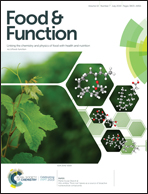The profiling of bioactives in Akebia trifoliata pericarp and metabolites, bioavailability and in vivo anti-inflammatory activities in DSS-induced colitis mice
Abstract
The fruit of Akebia trifoliata is popular in Asia, but researches concerning the phytochemicals of A. trifoliate pericarp extract (APE) and their metabolites, bioavailability, metabolism and anti-inflammatory activity in vivo are less known. In the present study, the chemical constituents of APE and their metabolites of rats after oral administration were identified using UPLC-LTQ-Orbitrap-MS/MS. A total of 18 compounds were tentatively characterized in APE, while 8 original compounds and 8 metabolites were observed in plasma, and 10 original compounds and 39 metabolites were detected in urine. Deglycosylation, glucuronidation, methylation and sulfation were the reactions that mainly occurred in the metabolism in vivo. Meanwhile, APE supplementation decreased dextran sulphate sodium (DSS)-induced colitis in mice, ameliorating epithelial barrier disruption, suppressing the proliferation and infiltration of immune cells, modulating the secretion of nitric oxide (NO) and prostaglandin E2 (PGE2), decreasing the expression of nitric oxide synthase (iNOS) and cyclooxygenase-2 (COX-2) as well as regulating oxidative stress in vivo. The results suggested that APE triterpenoids and their metabolites as major contributors to anti-inflammatory activities, providing a scientific basis for the use of APE as a functional food to ameliorate colon health in humans.



 Please wait while we load your content...
Please wait while we load your content...